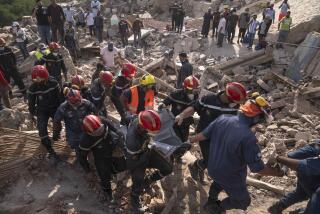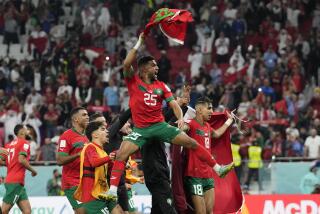In the Coils of the Charmers in Old Morocco
- Share via
Going six days by motor coach through Morocco is like falling, like Alice, into Wonderland.
Despite the modern European crust on such cities as Tangier and Casablanca, which have been so romanticized in American movies, Morocco is ancient, Muslim, exotic and inescapably African.
Our group was too sophisticated to look for Rick’s bar in Casablanca, but just to erase any fantasies that we might have had, our tour guide told us: “Humphrey Bogart was never in Casablanca in his life. The whole thing was shot on a set in Hollywood.”
Our first glimpse of Morocco was of the shining white city of Tangier, gleaming on its point like the San Francisco of the 1940s. Crossing the Strait of Gibraltar by ferry, we had seen “the Rock,” that symbol of colonial domination, vanish in the mists, proving as illusory as the world’s financial structure had that week.
The roads between Morocco’s teeming cities go back 2,000 years. Bent old men in robes plod beside their heavily laden donkeys. Women carry great loads on their heads. Morocco’s two main beasts of burden are still women and the donkey.
In the cities we passed rows of sidewalk cafes patronized only by men sipping coffee fraternally at their tables. Women paraded by with laundry on their heads. About one in four was veiled. Rarely we saw a young woman in a short skirt taking coffee with the men; a student, perhaps; a feminist; a herald of change.
Once on the road we stopped to watch a young man lead a donkey to a well and fill his jugs; across the road, up the hill a way, a donkey was lifting water from a well by rope. Beaten by a small boy with a stick, it would walk reluctantly downhill, bucking now and then, to raise a bucket that had been lowered into the well by a man.
“Don’t be surprised,” our tour guide told us, “if we see some camels later on.”
Sure enough, a few miles down the road we saw six camels standing off to the left with a camel herd. I was just slightly suspicious that these little sideshows had been arranged.
We soon came to Rabat, the king’s home. We circled shining public plazas and crawled across a monumental square to pull up before the king’s palace. It is a pile of incalculable size, but graceful in design, and decorated with tiles in the green color favored by the king’s direct ancestor, Mohammed the Prophet.
In Marrakech we went in the late afternoon to Jemaa el Fna, an enormous square in which thousands of Moroccans meet daily in an open-air bazaar and circus. Peddlers swarmed around us like gnats; dozens of them selling bracelets and caftans and other artifacts.
A woman with a baby in a sling on her back slipped a bracelet over my wife’s hand. “Is gift,” she said.
Before my wife could give the gift back she had bought four bracelets. (In the bus later she found that she had paid twice as much as the other women. She is not a good bargainer.)
A small boy attached himself to my sleeve. He looked up at me with enormous, hungry, appealing eyes.
The Moroccans are a beautiful people, slender and fiercely handsome. They have long, sculptured faces, voluptuous lips and darkly eloquent eyes. The children smiled at us a lot and said hello.
My wife called my name. I turned to see that a snake charmer had coiled a snake around her neck. She had one hand on it. Her face was frozen. She handed me her camera. If she had to go through this, she wanted a record of it. I snapped a picture and the snake charmer demanded payment for the service.
In a moment I realized that someone had placed a monkey on my shoulder. “I don’t want a monkey on my shoulder,” I told the monkey trainer. My wife recorded the moment on her camera and I paid.
And yet, the circus was not merely for tourists. It had been going on for centuries, probably, and would go on when we were gone. Crowds of Moroccans circled acrobats, dancers, musicians, fighters, fortune tellers. Breads, meats, nuts and spices were sold; on the periphery hot foods sizzled on open grills.
That night we ate couscous and other Moroccan dishes outside the city under Bedouin tents, entertained by musicians and harem girls chanting erotic slave-girl songs, and fierce men on Arab horses rode toward us over an arena, firing rifles in the air.
More to Read
Sign up for The Wild
We’ll help you find the best places to hike, bike and run, as well as the perfect silent spots for meditation and yoga.
You may occasionally receive promotional content from the Los Angeles Times.





